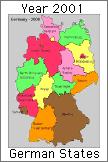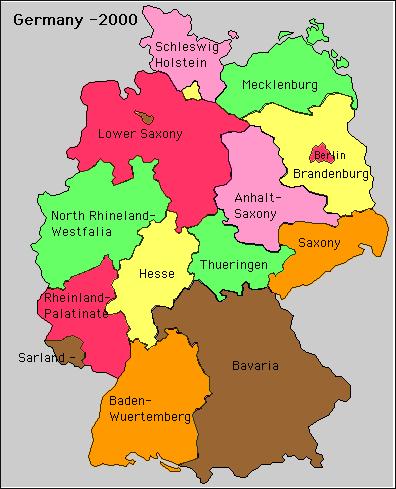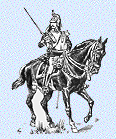
Year 2000: a quick reference of Germany's Laenders [state-like] plus their capitals:
-
Anhalt-Saxony = Anhalt-Sachsen
- Magdeburg
-
Baden-Wuerttemberg
- Stuttgart
-
Bavaria = Bayern = Free State of Bavaria = Freistaat Bayern
- Munich = Muenchen
- Bayern : see Bavaria
-
Brandenburg
- Potsdam
-
Bremen [City State = Stadtstaat]
- Bremen
-
Hamburg [City State = Stadtstaat]
- Hamburg
-
Hesse = Hessen
- Wiesbaden
- Holstein: ssee Schleswig-Holstein
-
Mecklenburg = Mechklenburg-Vorpommern [West Pomerania]
- Schwerin
- Niedersachsen : see Lower Saxony
-
North Rhineland = Westphalia =North Rhine-Westphalia =
Nordrhein-Westfalen
- Duessesldorf
-
Lower Saxony - Niedersachsen
- Hannover
-
Rheinland-Pfalz = Rhineland-Palatinate
- Mainz
-
Saarland
- Saarbruecken
-
Saxony-Anhalt = Sachsen-Anhalt
- Magdeburg
-
Schleswig - Holstein
- Luebeck
-
Thueringen = Thuringia
- Erfurt
- Westphalia = Westfalen : See North Rhineland-Westphalia

-
Alphabetical List of Dependencies of The Holy Roman Empire Before 1806
Keys for List for the Dependencies of the Holy Roman Empire:
German Translated to English
Summary of the Kaiser's Tenants-in-Chief and the Kaiser's Other Direct Dependents
Kurfuersten = electoral princes
Fuersten = ruling princes:
- Archbishops and bishops
- Deutschorden Balleien
- Prelates nullius: abbots and cathedral chapters
-
Prelates nullius: Abbesses
- Example: Quedlinburg Abby See "Q"
- Secular princes (Germans)
- Secular princes (Foreign)
- Counts and Lords
Reichsstaedte (Imperial Cities)
Kurfuerstenkolleg (College of Electoral Princes)
Reichsfuerstenrat (Council of Princes):
-
Religious:Archbishops, dukes, Deutschmeister
- Bishops
- Abbots
- Swagian prelates nullius
- Rhenish prelatesnullius
-
Representitives:
- Princes and Marquises
- Wetterauische Counts
- Schwaebische Counts
- Fraenkische Counts
- Westfaelische Counts
Collegium of cities:
- Rhenish Bench
- Swabian Bench
Treaties Often mentioned with Dates:
- Peace of Westphalla - 1648: Treaty drawn up after the Thirty Years War
Free Hanseatic City [Freie Hansestadt]
- Example: Bremen
List of Other German words needed for understanding the list are:
- Baron = rank of nobleman below a Count who could be a "Freiherren" (Free lord) of an estate which is part of secular office with a lay judge (Schoeffen)
- Briefadel = Nobles after 1350 who are "holders" of written patents; in royal ceremonies they follow the older nobles known as Uradels
- Burg = fortress
- Deutschorden = ref. to German Order of the Teutonic knights (Deutschritter)
- Deutschritter = German knights of the German Order (Deutschorden)
- Edel = nobles
-
Edelleute = "persons of quality" ref. to Prussian noble families
- they may have lost their title, may no longer hold land for the Emp. or King, perhaps a member of the family had distinguished themselves but never held title....
- Freiherren = Free Lords = Barons [Freiherr = Baron...(singular)]
- Freimann = Free man
- Freistaedte = free town. See Reichstaedte (Free city)....
- FRG = Federal Republic of Germany
- Furst = Prince (singular of Fuersten = Princes) See Fuersten
- Fuerstlich = princely
-
Fuersten = ruling princes
-
In earlier years of German history Fuersten were over- regional
magnates who's families often date back to the times when
they were leaders (kings; chiefs) of groups and, or, tribes who had
ruled an area (country, land).
- Good example is the ancient Hungarian Zapolya family who were Fuersten. A Zapolya rose to Gov. of Hungary and later his des. was elected to be John I, King of Hungary in 1487. His des. retained the titles of Fuersten and Fuerstin as des. of the ex-royal family under the Hapsburgs who took the terrritory of Hungary at the death of John I Zapolya, King of Hungary .....
-
In earlier years of German history Fuersten were over- regional
magnates who's families often date back to the times when
they were leaders (kings; chiefs) of groups and, or, tribes who had
ruled an area (country, land).
- Fuerstin = ruling princess
- Gaue = Count's region
- Graf = a Count in areas which are settled = local administrators for the various regions (Gaue) of the Kaiser; ranked below a Markgraf
- Grafen = Counts (plural of Count). See Count
- Grossherzogtum = Grand Duchy = territory ruled by a Duke or Duchess
- Herrschaft = territory of a nobleman who is usually of lower rank
- Herrschaften (plural of Herrschaft) See Herrschaft
- Herzog = Duke who was appointed in frontier areas needing military protection = sovereign of a small state = highest hereditary rank outside the royal family
- Hoch und Deutschmeister = Teutonic Order of Knights
- Inmatrikuliert = noble families certified and seated in Galicia
- Kreis = reference to a regional. grouping of a community similar to that of a county in a state in the USA
- Kaiser = Emperor
-
Kur = prefix with reference to a territorial
designation of the ruling prince and or elector of the
Kaisers (emperor's)
-
Kurfuersten = see
Reichsfuersten (Seven Princes of
the Relm created in 1257)
- When viewing docuuments it is important to know when the title of "kurfuerst" was issued
- Kurfuerstenkolleg = college of electoral princes
- Kurfuerstentum = Electoral Principality
-
Kurfuersten = see
Reichsfuersten (Seven Princes of
the Relm created in 1257)
- Land = state
-
Landgraf = Count of the state
- Example - Pfalzgraf bei Rhein = Count of Pfalz (Palatinate on the Rhine)
- Landkomtur = district offices of the German Order of the Teutonic knights (Deutschorden)
- Landvogtei = regional administrative district under the supervisions of the vice-regent
- Markgraf = Margrave [Marquis] = a noble rank which is below a Duke and above a Count; appointed in frontier areas which needed military protection
- Mahrische Adel = Noble families of Moravia
- Personalists = ref. to a member of the Reichstag which was limited to nobles who held tenancies-in-chief of the Kaisers until the 18 th c. and afterwards ref. to nobles who held lands who were given seats in the Reichstag and did not have to have tenancies connected to the Kaiser
-
Prinzen = Princes
- In early times of German history Prinzen (Princes) were brothers to Fuersten (Princes who were over- regional magnates who's families date back to the times when they were leaders (chiefs of tribes)
- Regierungsbezirk = governmental district
-
Reich = empire or ref. to something imperial
-
Reichsfuersten = Kaiser's princes = Princes
of the Relm
- Before 1257 all Princes of the Relm had been Electors but after 1257 there could be only seven Princes of the Relm and this right was called "Kur" and the seven Princees of the Relm were called Kurfuersten
- Reichsfuerstenrat = Kaiser's council of princes
- Reichsstadte = imperial city granted a charter which may give it status of self government under the Kaiser's protection making them free of local patricians or territorial magnates whose lands surround the city or town (Freistaedte)....
- Reichsstand or Reichsstaende or Reichsstandschaft are class or classes of imperial ecclesiastic and secular nobles who held seats in the Reichstag
- Reichstag = Kaiser's parliament = German Parliment; modeled after the House of Lords of Great Britian;
-
Reichsfuersten = Kaiser's princes = Princes
of the Relm
- Roemische Kaiser = Roman Emperor crowned by the Pope
- Schloss = castle
- Schoeffen = lay judges whom Counts and Barons count appoint to settle differences
- Uradel = nobles who existed before 1350 and may have been a part of the old Carolingian times... See Briefadel
- Verwaltungsbezirk = district administrations
- Vogt = overseer, bailiff, sheriff, or, administrator
- Vogte = administrators of church lands
-
Wappenbuecher = official book with the German coat-of-arms (Heraldry;
Armorial Bearings)
-
Siebmacher' schen Wappenbuecher = Johann Siebmacher (Sibmacher), who
was a pointer and sketcher living in Nuernberg published in 1596
a collection of copper etchings from the Wappenbuechlein
- Ausgaben = Issues by Siebmacher's wife after her husband's death in 1611 and then by others after her death to 1806.
- Issues from 1854 to 1961 are part of the "new Siebmacher"
-
Siebmacher' schen Wappenbuecher = Johann Siebmacher (Sibmacher), who
was a pointer and sketcher living in Nuernberg published in 1596
a collection of copper etchings from the Wappenbuechlein
- Website: http://www.genealogienetz.de/misc/nobility_faq.html
Historical Dates Most Often mentioned:
-
abt 375 to 800 - Great migration to the end of the Carolingian [Frank]
Empire
- 800 to 1517 - Middle Ages to Decline of Catholic Church in German states
- 751 - Charlemagne extends his rule over the territories of Saxon, Bajuwari (Bavarians) and into northern Italy and with him came his Catholic religion
- 843 -Treaty of Verdun and the dissolution of the Frankish state
-
900 - 1517 - Middle Ages to Reformation
- 919 - Heinrich I, Saxon King was crowned and united Franks, Saxons, Swabians and Bavarias and the term Kingdom of Germans [Empire of Germans/Regnum Teutonicorum] is implied......
- 962 - Otto I, son of Henry I, crowned Emperor of the German states in Rome...
- 1276 - Count Rudolf I, son of Albert IV Hapsburg [Habsburg, a minor Count from Switzerland], was created King of Austria through the Electors of the Rhine and he and his des. would rule Austria from 1276 to 1918
- 1417 - Frederick I (Hohenzollern) becomes Elector of Nuremberg
- 1438 - Albrecht II [Hapsburg], crowned Emp. of the Holy Roman Empire
-
1517 to 1648 - Reformation
- 1500 - criticism of abuses of the Catholic church becomes public and desire for changes stirs religionious ideas and theories in German states
- 1517 - Martin Luther nailed his "theses" of abuses of "indulgences" to the church door in Wittenberg
- Conflicts was long and bitter and continued
- Germany is divided between Catholics [Hapsburg and the Holy Roman Empire) and Reform, also, known as Protestants [Hohenzollerns and others who became Lutherans, Calvinists, Zwinglians.
- 1618 to 1648 - Thirty Years War
- 1640 - Frederick Wilhelm I (Brandenburg-Hollenzollern) accession to the Brandenburg throne
- 1648 - Treaty of The Peace of Westphalia is the historical mark that ended this period of time
-
1648 to 1792 - Treaty of the Peace of Westphalia to French
Revolution
- 1701 - Frederick I [Hohenzollern] crowned as King "in" Prussia and unites Brandenburg and Prussia into one large Protestant German state and becomes a powerful rival of the Catholic Hapsburgs of Austria who hold the crown of the Holy Roman Empire
-
1792 to 1815 - French Revolution to Rise and Fall of Napoleon
- 1806 - Napoleon ends the existence of the Holy Roman Empire & establishes the Confederation of the Rhine under Napoleon's protection
- 1814 - Napoleon invades Russia
- 1815 - Second and final defeat of Napoleon
- 1814 to 1815 - Congress of Vienna and Restoration of German states
- 1815 to 1919 - Restoration to the end First World War (Great War) and the signing of the Treaty of Versailles, 28 July 1919.....
- 1919 to 1945 to Second World War and the division of Germany into West and East by the Allies
- 1945 to 1989 to the fall of the Berlin wall on 8 Nov 1989
- 3 Oct 1990 - Reunification of Germany
See Important Dates In More Detail
List:
-
A / B / C / D / E /F / G / H / H2 / I /J / K /L /M /N /O /P /Q /R /S /T /U / V
I am told I have made a number of spelling errors on the following list.
As I have time I will try to find and correct these errors.
If you have found an error / or/ have any questions contact me.
Also, the word "presently" may be incorrect since some of the areas have changed in the last few years from what they were under the FRG [Federal Republic of Germany when this article was written. I hope to bring these changes up to the present of 2004.
In a message dated 2/25/04 7:18:35 AM, rajofcanada@yahoo.com writes:
<< Hi,
...My name is Rommel L. Manikan. I live in Vancouver, B.C., Canada.
I've been dabbling in royal European genealogy for more than 10 years basically as a hobby. I'm not a genealogy researcher, just an enthusiast.
Yes, I have a lot of information about the former German states or polities during the Holy Roman Empire. When I have the time, I will share with you so you can see whether they're worth adding to your profiles of German states.
....
Rommel >>
In a message dated 5/5/04 11:19:46 AM, CHClausHoffmann writes:
Hi,
nice page: have you already found out, that two states on your map of Germany are missing?
The first is in German "Freie Hansestadt Bremen"
Bremen is a state that consists of two cities: Bremen and Bremerhaven.
The state has only 650000 inhabitants.
The parliament has 100 members (after a reform some years ago maybe less). The Government is called "Senat".
The second state is: "Freie und Hansestadt Hamburg". Hamburg has 1700000 million inhabitants.
These two states are the last "survivors" of the free imperial cities of the holy roman empire.




